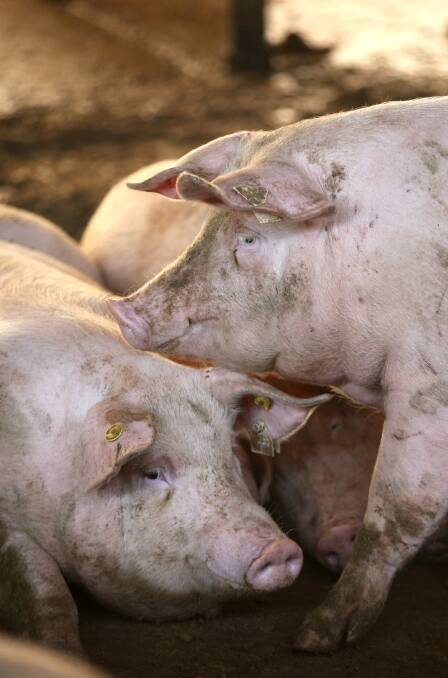
LAST week DAWR (Department of Agriculture and Water Resources) announced it has increased its border activities in response to the global spread of African swine fever.
Subscribe now for unlimited access to all our agricultural news
across the nation
or signup to continue reading
Part of this increased surveillance is being directed at international airports and mail processing centres presumably because they represent the highest risk of ‘front- door’ entry and it seems the heightened response is none too soon as the virus is literally knocking at that front door.
In a two-week period an undisclosed number of pork products were seized and from those seizures 152 were tested at the Australian Animal Health Laboratory in Geelong for the presence of the virus.
Six of those pork products were found to be positive, in other words contaminated with African swine fever virus.
Head of Biosecurity at the department, Lyn O’Connell, said detection of the virus in seized products at the border does not change Australia’s ASF-free status.
But if it does get beyond the front door and into our pig herd it would have, in Ms O’Connell’s words, “a significant impact on pig health and production and contribute to wider economic impacts caused by a loss of access to overseas markets for our pork products”.
Ms O’Connell said the department remained committed to keeping Australia’s $60 billion agricultural industries free from the disease but she added, “It is crucial that all participants in Australia’s biosecurity system play their part in managing this threat.”
In particular she singled out people visiting or returning to Australia from countries where the disease is present.
Travellers in the first instance should be aware of the biosecurity requirements and not bring banned products with them and if they are carrying foods, plant material or animal products in their luggage they must declare it on their incoming passenger card, she said.
To internet shoppers she advised, “Before making online purchases, check what can and cannot be mailed to Australia. If you are unsure of an item, declare it, or don’t bring it at all.”
Coincidentally just two days before the DAWR announcement, Reuters carried a story that China has now culled 916,000 pigs due to ASF since the first outbreak was detected in August 2018.
Citing an official update from the Chinese Ministry of Agriculture and Rural Affairs the report put the number of outbreaks at more than 100 despite months of biosecurity effort limiting transportation of pigs.

Meanwhile in the US, the pork industry is working on its own action plan to help prevent the introduction of ASF there.
Cross-sectoral collaboration involving representatives from the National Pork Board, National Pork Producers Council, North American Meat Institute, US Department of Agriculture, Swine Health Information Centre and the American Association of Swine Veterinarians will create a new body called the National Swine Disease Council.
Its role will be to monitor emerging pig-related diseases and work with state and federal officials to respond quickly and effectively with best actions to mitigate the risk to herd health.
Cow price plummets as heat and dry worsens
IN the closing months of last year, saleyard markets in southern NSW and Victoria were well supplied with cows to the point that southern Queensland operators were able to bring substantive numbers north to supplement their kill.
Since then with the roll over into the New Year, the southern weaner sales have started.
This potentially frees up even more cows to hit the market should the need arise and latest indications from the south suggest that the continuing heat and dry down there is elevating need into necessity with a dash of urgency for good measure.
At Wagga on Monday MLA’s market reporter commented on the large number of outstanding quality Shorthorn and Angus cows offered, some only three years of age. It seems the only reason for their presence was that their owners had run out of water.
Heavyweight score 3 and 4s made up the better part of the 900 plus cow offering and met with what was described as subdued interest from the buying panel. Prices plunged by 16-17c/kg resulting in a range from 162 to 205c and a combined average of just 187c. That converts to a dressed weight price of around 370-380c/kg.
But unlike the situation late last year where Queensland continued to exhibit a price advantage over southern states, that advantage may now be starting to unwind with the result that rates up and down the eastern seaboard move closer into alignment.
Toowoomba on Monday was not overwhelmed with cows but the couple of decks of good heavy types were 46c cheaper to average just 187c. However market reporter Trevor Hess mentioned that some of the major exporters were not operating at Toowoomba on Monday.
Warwick and Dalby will be a better test with substantial numbers expected at both centres.
Kill building rapidly
MLA’s slaughter figures for last week (week-ending Jan 18) indicate that the national kill is rapidly rebuilding to pre-Christmas level.
Already all the southern states are right up there and Queensland will not be far behind with Stuart meatworks at Townsville starting this week and major plant Dinmore expected to step up to full production next week.
NSW recorded 35,419 which was bettered only four times in all of 2018. Similarly Victoria killed 26,491 for the week and again there were only four weeks at the end of last year when the kill there was marginally higher. Queensland killed 53,415 which took the national (eastern states) tally to 126,419.
After just three weeks, the progressive national count is ahead of 2018 by 20,000 head. Published and non-published grids have come off the opening rates for the year by at least 20c with indicator 4-tooth ox now at 525c/kg and heavy cow at 445-450.
Southern Queensland works are reported to be about three weeks out with direct bookings and around two weeks for Rockhampton and Townsville.

